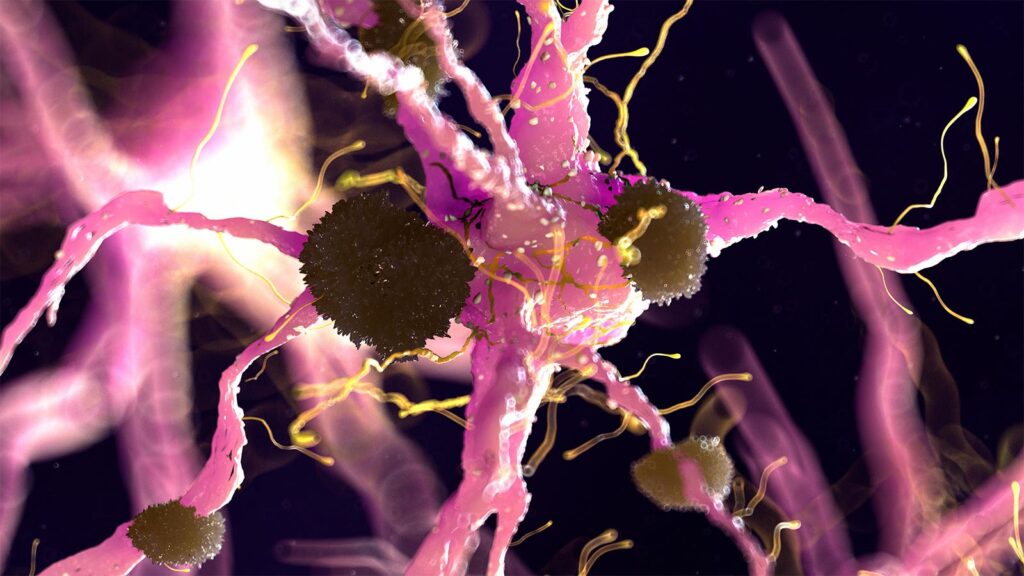[ad_1]
- The Florey Dementia Index predicted when cognitive decline or Alzheimer’s dementia would occur.
- The index is based on age and dementia severity test scores.
- The model performed well in several cohorts but more testing is needed.
A novel tool known as the Florey Dementia Index (FDI) predicted onset age of mild cognitive impairment or Alzheimer’s disease dementia, a prognostic study showed.
Using data from nearly 3,800 older adults, the FDI showed mean absolute errors of 2.78 years (95% CI 2.63-2.93) for predicting mild cognitive impairment onset and 1.48 years (95% CI 1.32-1.65) for predicting Alzheimer’s dementia onset, reported Yijun Pan, PhD, of the University of Melbourne in Australia, and co-authors in JAMA Network Open.
In a simulated trial of 93 participants from the Anti-Amyloid Treatment in Asymptomatic Alzheimer (A4) study, the FDI showed mean absolute errors of 1.57 years (95% CI 1.41-1.71) for predicting mild cognitive impairment onset and 0.70 years (95% CI 0.53-0.88) for predicting the onset of Alzheimer’s dementia.
The FDI uses age and Clinical Dementia Rating Sum of Boxes (CDR-SB) scores for prediction. The CDR-SB assesses dementia severity.
“To our knowledge, the FDI model is the first to accurately predict the onset of mild cognitive impairment using only a single neuropsychological test and age,” Pan and co-authors wrote. “Although the use of advanced imaging, biomarkers, and multiple neuropsychological testing data in models could enhance prediction accuracy, such data are often costly to collect and not easily accessible.”
A tool that can forecast onset age could help older adults plan dementia care while they’re still capable of doing so, the researchers pointed out. With the advent of disease-modifying therapies, estimating when cognitive impairment starts could be clinically meaningful because monoclonal antibodies against Alzheimer’s amyloid are indicated for early disease.
To develop and validate the FDI, Pan and colleagues used data from 1,665 participants in the Australian Imaging, Biomarker, and Lifestyle (AIBL) study and 2,029 people in the Alzheimer’s Disease Neuroimaging Initiative (ADNI). Data were collected from October 2004 to March 2023.
All participants were older than age 60 and had at least two records of CDR-SB scores. People with mild cognitive impairment or dementia from non-Alzheimer causes were not included in the study.
In AIBL, 44.5% of participants were women, and mean ages at first and last evaluations were 72 and 78. At the final assessment, 81.1% of AIBL participants were cognitively unimpaired, 8.6% had mild cognitive assessment, and 10.3% had Alzheimer’s dementia.
The ADNI cohort had 45.6% women and mean ages at first evaluation and final evaluations were 75 and 78. At the final evaluation, 33.3% were cognitively unimpaired, 32.3% had mild cognitive impairment, and 34.4% had Alzheimer’s dementia.
Data from the A4 study were used in a simulated trial. Unlike the AIBL and ADNI, the A4 study consisted of people with elevated amyloid-beta and normal cognition. Mean ages at baseline and final assessments were 73 and 82. At the final evaluation, 76.3% of A4 participants developed mild cognitive impairment and 23.7% progressed to Alzheimer’s dementia.
To develop the model, the researchers calculated a mean CDR-SB by averaging scores of AIBL participants across different ages and plotted this against age. They performed a survival analysis to estimate the probability of cognitive impairment for a given FDI, and evaluated the model’s performance in the ADNI cohort.
The model’s performance was not improved when APOE4 status was considered. “This is likely because cognitive decline, as assessed by the CDR-SB, is influenced by the presence of APOE4,” Pan and colleagues said.
Accounting for sex improved Alzheimer’s dementia prediction, but wasn’t a conclusive factor in predicting mild cognitive impairment. All comorbidities except psychiatric disorders decreased the mean absolute error of predicting mild cognitive impairment onset age by approximately 15%, but had a limited influence on predicting dementia onset.
The FDI performed best in the simulated trial, which might be because A4 participants were assessed with amyloid PET and had tightly controlled follow-up intervals, the researchers noted.
“The outstanding performance of the FDI model developed using the AIBL dataset in predicting mild cognitive impairment and Alzheimer’s dementia onset in both the ADNI and A4 cohorts strongly suggests that our FDI model is robust, with a very low likelihood of overfitting,” Pan and co-authors wrote. “However, further evaluation in diverse dementia cohorts is still necessary.”
The model was developed using Alzheimer’s data and excluded people with cognitive changes from non-Alzheimer’s causes, the researchers said. Study participants might not reflect the general population, they acknowledged.
“Like other digital health tools in their early development phase, further work will be needed to optimize the FDI and enhance its clinical utility,” they noted.
Disclosures
This project is funded by the National Health and Medical Research Council (Australia), the Telematics Trust, and the Alzheimer’s Association. Data collection and sharing for this project were funded by the Alzheimer’s Disease Neuroimaging Initiative via the National Institutes of Health and the U.S. Department of Defense.
Pan reported relationships with the Bethlehem Griffiths Research Foundation and Brain Australia.
A co-author reported relationships with the National Health and Medical Research Council (Australia), the BGRF Foundation, Brain Australia, and National Institutes of Health. No other disclosures were reported
Primary Source
JAMA Network Open
Source Reference: Chu C, et al “Development and validation of a tool to predict onset of mild cognitive impairment and Alzheimer dementia” JAMA Netw Open 2025; DOI: 10.1001/jamanetworkopen.2024.53756.
Please enable JavaScript to view the comments powered by Disqus.
[ad_2]
Source link : https://www.medpagetoday.com/neurology/alzheimersdisease/113710
Author :
Publish date : 2025-01-09 18:20:26
Copyright for syndicated content belongs to the linked Source.
